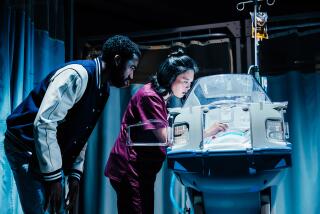A Grueling Labor--but Dad Weathered It
- Share via
As the world-famous Garden Grove fertility specialist used a simple line drawing to describe the surgery that might enable my wife to become pregnant after six years of attempts, I passed out on the floor of his office.
Looking up seconds later at the three anxious gynecologists called in to help revive me, I decided that it was going to be a long nine months if that or any other surgical procedure was successful. Staying on my feet for what was to follow became a major goal. After all, tough guys don’t blanch.
Dismiss from your mind the caricature of a harried Dagwood Bumstead pacing outside the delivery room, at least for the moment. I am an ‘80s kind of guy, and in the past 20 years of writing and roaming, I have been around some. I have seen some extremely unpleasant things--trust me--all without losing consciousness.
But injections, blood tests and clinical discussions involving my medical condition (and now my wife’s), have always had a tendency to make me go--successively--gray, green, clammy and down. I have folded following the removal of a wart and at a stress test.
The best I can figure, it has something to do with imagining my own mortality. Surprisingly (to me), when the issue is less abstract and more critical I have held up quite well, as I did during my wife’s fertility-related surgeries in Garden Grove.
In any event, technology and precision timing ultimately triumphed, and the nine-month countdown began. There is nothing like turning 40 and facing fatherhood for the first time--both in the same month--to firmly focus your attention on the future.
At 16 weeks, we went to the hospital for the amniocentesis, in which a long needle is inserted into the uterus to take a sampling for genetic screening, and the old squeamishness returned: I had to sit in the hallway just outside the room where the sample was taken, making my mind go elsewhere.
I did about as well when I had to give a blood sample to screen for Tay-Sachs disease, which sometimes affects descendants of European Jews. I forewarned the nurse and cooled out afterward on an examination table.
At seven months, I closed my eyes during the Lamaze class when the slides of a Caesarean section flashed on the screen and, later, at the sequence of an actual birth. One viewing would be entirely sufficient, I said.
All along, my wife and I joked that when the time came, we would ask for adjoining gurneys in the delivery room, that I would ask for the same drugs Sallie did. I said I would guarantee that I would be with her for the birth--New Age peer pressure can be overwhelming--but I just couldn’t guarantee that I would be conscious.
A week past her due date, when Sallie called me from the hospital and said the doctor had decided to induce the birth, it was Bumstead redux. I made three wrong turns on the well-worn route to the hospital. The following day in the delivery room, after 30 hours of off-and-on labor and another ride to the hospital, I first misunderstood the doctor, confusing the anesthetic known as the epidural with the surgical procedure called episiotomy and thought I had missed everything.
Straightened out by the doctor, I still looked away when the anesthesiolgist inserted the epidural needle--which appeared huge to me--under my wife’s skin.
But during the final stages of delivery I did fine, coaching at Sallie’s side throughout. When our hefty son emerged, weighing in at 10 pounds, 9 ounces, I was alternately laughing and grinning ear to ear, as Sallie exclaimed, “You didn’t faint!”
I didn’t, but then I watched the baby’s emergence only out of the corner of my eye and completely avoided the repair work on my wife that followed. Nobody in the room offered me the opportunity to cut the umbilical cord, and I didn’t ask. I did manage to snap a few shaky pictures.
Back home from the hospital, I admit to wavering at the first fully loaded diaper, but the crucial test came on the eighth day. That was when we had the Brit Milah, the ritual circumcision that marks God’s covenant with the Jewish people. Midway through the religious and surgical procedure, seeing my son restrained and vulnerable, I got that lightheaded feeling. About the time the rabbi pronounced our son’s name, Asher, I started to go ashen and broke out into a cold sweat. Fortunately, there was a chair to drop into, and I made two more brief attempts to rejoin the proceedings.
A baby, after all, is a physical extension of yourself, so it is only natural that you feel--emotionally at least--whatever happens to him. Thus, I held my own breath when I immersed my son in the mikvah, the ritual bath, an experience he seemed to appreciate about as much as the circumcision.
And, true to form, when the time came for Asher’s first inoculation, I looked away, just as I do when I am getting the needle. Maybe he will do better.






